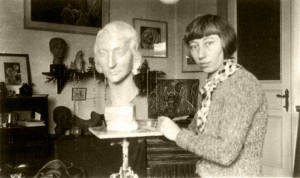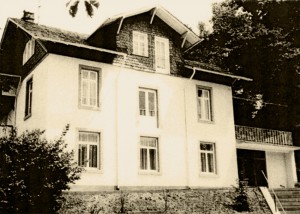
The majority of the Frankfurt Jews who went into hiding escaped from the city. The air raids on the city offered many people the opportunity to apply for substitute documents as air raid victims and thereby hide their true heritage. Only when they had obtained such an ID card were they able to apply for the important ration card. However, to report being bombed out in Frankfurt seemed too risky.
The situation was different for the Berlin Jews. The city was immense and the anonymity of the big city offered possibilities to disappear from the old-established neighborhood. The Berlin Gestapo was aware of this weakness and recruited “snitchers” who reported fellow Jews in order to save their own lives. That is why persecuted people from Berlin sought alternate accommodations illegally in Frankfurt.
Toni Schneider escaped from Berlin. She was Dr. Günther Schneider’s mother who ran the x-ray department at Frankfurt’s Gagern Hospital. She was hidden in the Schäfer family’s house and provided with the cover name Margarete Maurer. This was a successful disguise because two sisters, whose last name was also Maurer, lived as sub-tenants in the house. Toni Schneider survived.
See: Petra Bonavita: Mit falschem Pass und Zyankali, Stuttgart 2009, page 138.
Adelheid and Werner Müller lived in Berlin and were amongst those Jews who were forced to work in industrial companies deemed to be important for the war. During the so called “factory action” at the end of February 1943 they were supposed to be deported and went into hiding with their three year old daughter. A small circle of friends had discussed for a long time how they could help the family if they were to be deported. Franz Streit offered to help. He worked in Anton Saefkow’s resistance group. Hedwig Wittekind, a sculptress, was also a friend of the musician couple. Therefore Werner Müller went into hiding by Franz Streit, while at the same time Adelheid Müller and her three-year-old Tanja “went on a trip”. Adelheid was unable to handle this over a long period of time; in May she returned to Berlin and went into hiding at Hedwig Wittekind’s studio. However, the situation was also dangerous for Wittekind. She lived on money provided by her father who lived in Büdingen, because she was unable to survive as a sculptress during the war. The group decided that Wittekind should return to her parents’ house and take three year old Tanja with her. A subsequent entry in the residents’ registration records in Büdingen in October 1943 proves that Hedwig Wittekind lived again in her parents’ house. There is however no entry for Tanja Müller.
It is not known how Hedwig explained the child’s existence to her parents. She was 47 years old and had been unable to support even herself from her sculpture work. It is known however that she did not get along with her father’s second wife, who considered Hedwig’s bohemian lifestyle unacceptable. That could possibly be the reason that Tanja Müller was housed in the Nazi children’s home “Am Wildenstein”, which was located only 100 meters behind the Wittekind’s house in Büdingen.
In the meantime Franz Streit lived with Adelheid and Werner Müller in Wittekind’s studio in Berlin-Friedenau. All three of them were arrested there on 20 July 1944. Franz Streit was executed six months later for having belonged to Saefkow’s resistance group. Werner Müller died in a concentration camp; his wife survived. She was able to bring her daughter Tanja back to Berlin from Büdingen.
Hedwig Wittekind is remembered as a courageous and just person. According to the text of her death notice, which appeared after she died on 31 October 1949: “Externally she was poor, but internally she was rich.”

The escape from Berlin via Frankfurt and ultimately to Straßburg ended tragically for two women and their three children. The two sisters Gerda and Eva Rothschild were born in Straßburg and lived in Frankfurt since at least 1939. A non-Jewish relative with the same name lived with them in the ghetto house located at Hans-Handwerk-Strasse 63 (today: Langestrasse). Two months after the birth of Judis Rothschild the two women escaped the deportation proceedings and fled to Straßburg. They managed to survive with the baby and two ten year old children until the end of 1943 when their names appeared on a prison list. They were transferred from the Straßburg prison to Berlin on 12 January 1944, and shortly thereafter, on 20 January 1944, were deported to the concentration camp Auschwitz where they were murdered.
The couple Max and Rosa Sachs along with their twenty-year-old twin daughters went into hiding in Berlin. After one month they decided to escape to the Ruhr area. They were convinced that they have a greater chance of getting by there as air raid victims because this area had been heavily bombed. Max Sachs based his decision on the fact that there was so called free food after each bombing. “Their luck” was tied to many air raids. They went from Bochum to Kassel and back to Dortmund again, which was a fateful location for them. Their twin daughters were arrested on 29 June 1943 while the parents were away and were deported to the concentration camp Auschwitz via Berlin in August 1943. Max and Rosa Sachs wandered here and there and finally lived in Frankfurt as of 30 August 1943: first as sub-tenants on Seehofstrasse, then on Moselstrasse in the “Hamburger Hof” Hotel and then as sub-tenants on Weserstrasse. They survived. They never saw their daughters again.